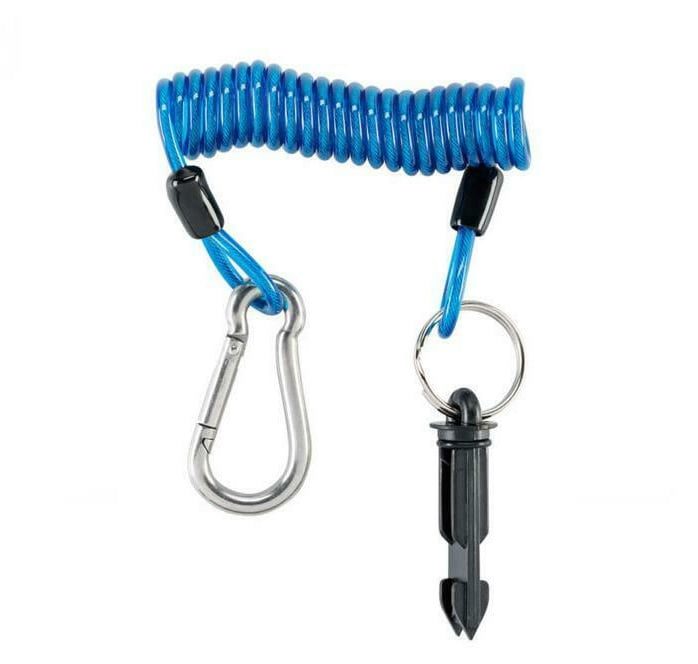Announcement posted by Couplemate Trailer Parts 05 Jun 2021
Lanyard Breakaway Switch Safety Alert
Lanyard breakaway switch general owner inspection alert for Caravans and trailers over 2000kg only.
Safety switch lanyards are approximately 120cm long whilst safety chains are 64cm long.
Surprisingly, most breakaway lanyards are installed incorrectly, making it impossible to disengage the breakaway pin, as intended.
Do manufacturers perfectly matches breakaway lanyards with safety chains?
A quick check of your caravan breakaway lanyard may shock you.
How the lanyard supposed to work
When the pin is pulled, safety chains have just past the full extension of the safety chains.
Further, this test is efficiently completed by attaching your chains to the tow bar and push your rig backwards.
Was your test successful?
Brakes not Engaged
In extreme circumstances, electric brakes are not engaged when the caravan or trailer becomes detached from the tow vehicle.
The minimum period for an electric brake system to engage whilst the safety chains are attached is 15 minutes.
Couplemate recommends the following inspections by owners and inspection stations.
- Firstly, check the lanyard is shorter than the caravan safety chains.
- Secondly, ensure breakaway switches are affected by water ingress, thereby causing failure when the pin is detached.
- Thirdly, pull the pin on your breakaway before every journey to test the current flow to the electric brakes. You should hear your magnets engage.
Electric brake magnets make an audible sound when engaging. As a result of not hearing your magnets engage, take your rig to your service centre for investigation.
CM702-Breakaway Instruction-Sheet
Towing Regulations
ADR62
- 0.1.1 This Standard is the Vehicle Standard (Australian Design Rule 62/02 – Mechanical Connections Between Vehicles) 2007.
SCOPE
The function of this vehicle standard is to specify requirements for devices for mechanical connections between vehicles and their fitment, in order to ensure positive mechanical engagement for vehicle combinations and to prohibit the opening or disengaging of devices under the action of any forces to which they may be subject to during normal use.
Note: The Scope covers couplings as the connection method between vehicles.
14.4. ‘Drawbars’ – Safety Chain Attachment Points
14.4.1. Any safety chain attachment point affixing a safety chain to a ‘Drawbar’ must be located as near as practicable to the ‘Coupling’. Where two points of attachment are required they must be mounted one on either side of the centreline of the ‘Drawbar’.
This section refers to safety chains as an attachment, as opposed to a connection.
Lanyard Coil Breakaway Switches
We recommend coil breakaway switches be adjusted correctly. Although they appear high tech, this type of connection cannot be adjusted to pull the breakaway pin in an emergency.
For example, with the chains at full stretch in an emergency situation, this type of coil lanyard cannot be pulled, therefore, cannot engage trailer brakes.
Lanyards must be installed correctly and checked at every service by a caravan dealer.
Breakaway Pins
Breakaway pins are subject to UV degradation. Replace the breakaway switch once the pin brakes due to age.
Copper Contacts
Install breakaway switches facing forward for the pin to be pulled forcefully during detachment.
Inspect the inside of the switch contacts for signs of dirt that causes failure during testing.
A breakaway switch with a rubber boot cover can be purchased here.
A breakaway switch may have to delivery 12.8 Amps to four magnets on a tandem rig. If the contacts are dirty, excessive heat is in the cable.
Lanyard Breakaway Test Failure
With the chains connected and the jockey wheel on the ground, push the caravan so that the safety chains are at full stretch.
If the pin fails to pull, measure the slack lanyard and shorten it. If the breakaway switch fails after being pulled, we recommend switch replacement and be sure to include a rubber boot to help prevent future water ingress.
Conclusion
Notably, breakaway switches are designed to engage electric brakes if the trailer or caravan becomes detached. During excessive sway, caravans can become dislodged.
When the pin is pulled, the electric brakes are immediately engaged, thereby stopped the sway and braking the caravan to a stop.
Noted: One interpretation in defence of the coil lanyard is during decoupling of the coupling and safety chain the brakes engage which in turn satisfies the ADR.
Love to hear your comments below
© Steve Wotherspoon 2th January 2018


